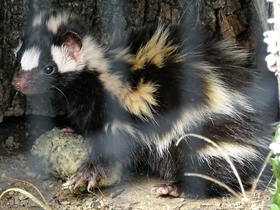The eastern spotted skunk (Spilogale putorius)
The eastern spotted skunk (Spilogale putorius) is a small, relatively slender skunk found in North America, throughout the eastern United States and in small areas of Canada and Mexico.
Distribution
Spilogale putorius is common in North America (from northeastern Mexico to the Canadian border of the USA, occurring in the Great Plains and as far north as Pennsylvania). Skunks inhabit wooded areas and tall grass prairies. The eastern spotted skunk inhabits agricultural areas with trees and shrubs in stony, desert areas, and is less common in low grass plains.
Description
The pinnae of Spilogale putorius are small and low on the sides of the head. Body length varies from 45 to 60 cm, tail length from 15 to 21.5 cm, weight ranges from 200 to 880 g. The body of the spotted skunk is covered with black fluffy fur, its tail is long and hairy. The skunk's anal scent gland is highly developed and secretes a powerful caustic liquid that is effective against all attackers. It contains a special muscular valve that allows the skunk to direct the fluid from the gland precisely to the target. The Spilogale putorius is of contrasting colour. Six white stripes are clearly visible on the front of the body, two stripes on the back, starting at the hips, and there are a couple more stripes on the ears and head. There is a white spot on the hips, two more at the base of the tail, the tail is black with a white tassel, the main body colour is black.
Nutrition
Spilogale putorius is omnivorous. It hunts small mammals and birds. Its diet changes seasonally: the skunk eats rabbits and corn in winter, field mice and insects in spring, insects (mostly), mice, birds and their eggs, and fruit in summer.
Behaviour
Spilogale putorius has a terrestrial and nocturnal lifestyle and is active throughout the year. It is good at climbing trees and rocks. To rest, it will seek shelter in hollow trees, dig a hole in the ground or occupy another animal's burrow. The skunk's mottled warning colouring is a good defence against predators. A slow (duck-like) gait also indicates that it is not edible. When confronted by its attacker, the skunk stands on its front legs and lifts its tail, exposing its anal glands. If the warning doesn't work, the skunk shoots a caustic liquid from its anal glands at its attacker, which can accurately hit its target at a distance of up to 4 metres. Splashes of skunk gland secretion entering the eyes can cause temporary blindness and nausea.
Reproduction
Spilogale putorius usually occurs in groups of several individuals, but they are not as social as the striped skunk. However, during the hibernation period there are sometimes up to 8 individuals in a burrow.
The mating period of Spilogale putorius is March-April, less frequently a second activity is observed in July-August. Embryonic development is characterised by diapause, when the fertilised egg remains inactive for 10-11 months. Pregnancy lasts 50-65 days, sometimes up to four months.
To give birth, the female Spilogale putorius establishes a den in an underground burrow, in hollow logs or rock crevices, and covers it with grass or hay. It gives birth to 2 to 9 cubs (usually 4-5). Newborn cubs are blind and defenceless, weigh 9-10 g and are covered with wool. The pups' eyes open on day 30-32. The mother feeds them with milk for 42-54 days. The pups can expel foul-smelling fluid from 46 days of age. At three months of age, Spilogale putorius pups reach adult size and reach sexual maturity at 10-11 months. The life expectancy of Spilogale putorius in the wild is usually a few years, but in captivity they live up to 10 years.
Conservation
The eastern spotted skunk has seen sharp declines in populations from several states, particularly those in the Midwest (such as Minnesota and Wisconsin). The exact reason behind the decrease in numbers is not known, which is puzzling considering the species was very quick to adapt to human settlement, and was commonly trapped up until the second half of the 20th century. Before then, they were frequently seen on farmlands, and were known to dig burrows under the sides of barns and prey on mice that were attracted to stored grains. In Minnesota, after a peak in the number of reported trapped specimen in 1949, during which over 19,400 spotted skunks were taken in that year alone, yearly reports of trapped spotted skunks in that state sharply fell in the following years. Pesticide use, modernization of farming techniques, over-trapping and consolidation of barns and other man-made structures are all believed to have had a negative effect on eastern spotted skunk populations; as a result, it has become possibly eradicated from several midwestern states, and on the whole is declining in that region. It is also declining in parts of the eastern US, such as Pennsylvania. Where it is not declining, the eastern spotted skunk is uncommon, although it remains common in Southern Florida. According to a population survey done in Alabama, the Carolinas, and Virginia, the Appalachian spotted skunk (S. p. putorius), the nominate subspecies, underwent a decline of about 3% per year between 2014 and 2020, with about a 50% mortality rate; predation from owls constituted the main reason for mortality throughout most of the range, but in North Carolina, a canine distemper outbreak killed half the marked (and a few unmarked) individuals over a few days.

















































